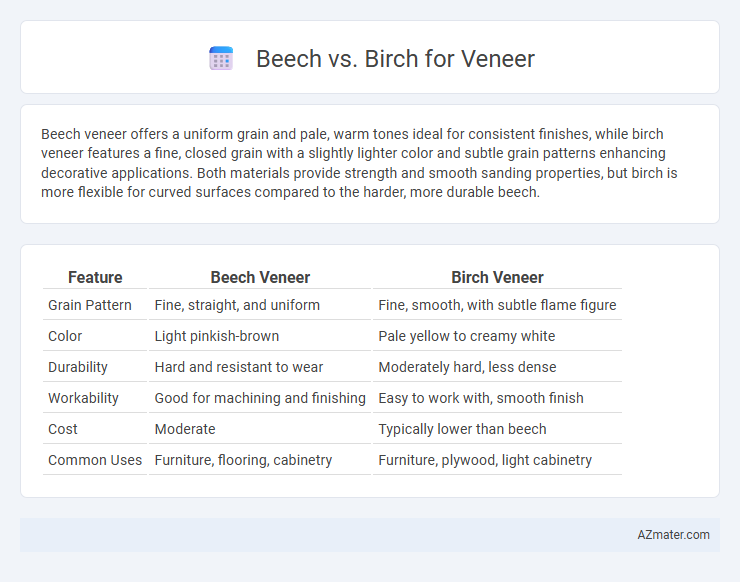Beech veneer offers a uniform grain and pale, warm tones ideal for consistent finishes, while birch veneer features a fine, closed grain with a slightly lighter color and subtle grain patterns enhancing decorative applications. Both materials provide strength and smooth sanding properties, but birch is more flexible for curved surfaces compared to the harder, more durable beech.
Table of Comparison
| Feature | Beech Veneer | Birch Veneer |
|---|---|---|
| Grain Pattern | Fine, straight, and uniform | Fine, smooth, with subtle flame figure |
| Color | Light pinkish-brown | Pale yellow to creamy white |
| Durability | Hard and resistant to wear | Moderately hard, less dense |
| Workability | Good for machining and finishing | Easy to work with, smooth finish |
| Cost | Moderate | Typically lower than beech |
| Common Uses | Furniture, flooring, cabinetry | Furniture, plywood, light cabinetry |
Beech vs Birch Veneer: An Overview
Beech veneer is valued for its fine grain and consistent light color, making it ideal for smooth, modern furniture surfaces, whereas birch veneer offers a slightly more varied grain and warm tones suited for rustic or traditional designs. Both veneers are durable and flexible, but beech tends to be harder and more resistant to wear, enhancing its suitability for high-traffic applications. Birch veneer also excels in stain absorption, allowing for diverse finishing options that highlight its natural patterns.
Botanical Differences Between Beech and Birch
Beech (Fagus spp.) and Birch (Betula spp.) differ botanically in their leaf structure, bark texture, and growth patterns, which influence veneer characteristics. Beech trees exhibit broad, ovate leaves with smooth, gray bark and a dense, hard wood grain, while Birch species often have more pointed leaves, lighter-colored, papery bark, and a finer, more uniform grain. These botanical distinctions affect veneer quality, with beech veneer favored for its durability and fine texture, whereas birch veneer is prized for its lightness and consistent appearance.
Appearance and Grain Patterns
Beech veneer features a fine, tight grain with a pale cream color that often includes subtle pink or reddish hues, creating a smooth and uniform appearance ideal for contemporary designs. Birch veneer displays a light yellow to creamy white tone with a slightly more pronounced and wavy grain pattern, offering a warm, natural look suited for both modern and traditional furniture styles. The choice between beech and birch veneer depends on the desired aesthetic, with beech providing a more consistent texture and birch adding visual interest through its distinctive grain variations.
Color Variations in Beech and Birch Veneers
Beech veneer displays a consistent light cream to pinkish-brown color with subtle reddish hues, offering a smooth and uniform appearance ideal for modern interiors. Birch veneer, however, features a wider range of color variations, from pale yellow and creamy white to light reddish-brown tones, often showcasing unique grain patterns that enhance natural highlights. These color distinctions make beech veneers preferable for projects seeking a uniform look, while birch veneers provide dynamic visual interest with their richer and more varied palette.
Durability and Hardness Comparison
Beech veneer offers superior hardness with a Janka rating of approximately 1,300 lbf, making it highly durable for heavy-use furniture and cabinetry. Birch veneer, with a slightly lower Janka hardness around 1,260 lbf, provides good durability but may be more prone to dents under extreme stress. Both woods have fine grain patterns, but Beech's increased density enhances its resistance to wear and impact over Birch in high-traffic applications.
Workability and Machinability
Beech veneer offers excellent workability and machinability due to its fine, tight grain and uniform texture, making it preferred for intricate designs and smooth finishes. Birch veneer, while also workable, tends to be slightly harder and denser, requiring sharper tools and slower machining speeds to avoid tear-out and maintain precision. Both woods respond well to staining and finishing, but beech's ease of shaping and sanding often makes it the top choice in high-detail veneer applications.
Cost Differences: Beech vs Birch Veneer
Beech veneer is generally more affordable than birch veneer due to its wider availability and faster growth rate, reducing production costs. Birch veneer, known for its fine grain and light color, commands a higher price because of its aesthetic appeal and relative scarcity in some markets. Choosing between beech and birch veneer depends on budget constraints and the desired visual effect, with beech offering cost-effective durability and birch providing premium quality.
Common Applications and Uses
Beech veneer is widely used in furniture manufacturing, cabinetry, and flooring due to its smooth texture and excellent workability. Birch veneer, known for its light color and fine grain, is favored for interior paneling, decorative plywood, and musical instruments. Both veneers offer durability and aesthetic appeal, but birch is preferred when a brighter, more uniform appearance is desired, while beech provides a warm, reddish tone suited for traditional designs.
Sustainability and Environmental Impact
Beech veneer offers a sustainable choice due to its fast growth rate and efficient regeneration, reducing deforestation pressure compared to slower-growing hardwoods. Birch veneer is also environmentally friendly, often sourced from sustainably managed forests with certifications like FSC, ensuring responsible harvesting and minimal ecosystem disruption. Both woods contribute to eco-conscious furniture and interior design by providing renewable materials with low carbon footprints when sourced and processed sustainably.
Choosing the Right Veneer: Beech or Birch?
Beech veneer offers a smooth, fine grain with a warm, reddish-brown hue, making it ideal for furniture requiring a classic, elegant appearance, while birch veneer features a lighter, creamy color with a subtle grain pattern, perfect for modern and minimalist designs. Both veneers are durable and easy to work with, but birch tends to have greater stability and resistance to warping, which suits high-moisture environments better. When choosing between beech and birch veneers, consider the intended application, color preferences, and environmental conditions to ensure the best match for your woodworking project.

Infographic: Beech vs Birch for Veneer
 azmater.com
azmater.com